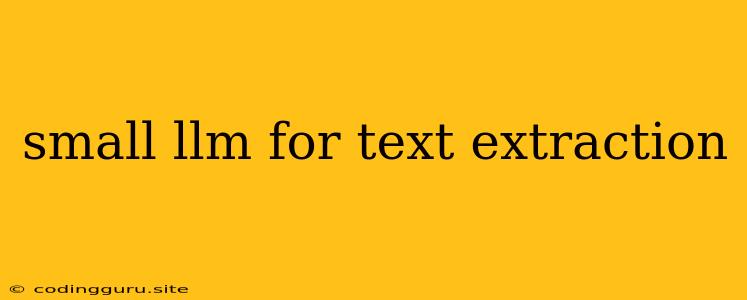Unlocking Information: How to Use Small LLMs for Text Extraction
The world of information is vast and ever-growing. Sifting through mountains of text to find the specific nuggets of data we need can be a daunting task. But what if we could harness the power of small LLMs to streamline this process?
Small LLMs are a powerful tool for text extraction, offering a unique blend of efficiency and accuracy. But how exactly do they work, and what are their specific advantages? Let's delve into the world of small LLMs and their application in text extraction.
What are Small LLMs, and Why Should We Care?
Large Language Models (LLMs) have taken the world by storm, demonstrating impressive abilities in tasks like text generation and translation. However, their sheer size presents challenges in terms of storage, processing power, and computational costs.
Small LLMs address these challenges by offering a more compact and efficient alternative. They are trained on smaller datasets, resulting in models that are lighter and more manageable. While they may not possess the same level of fluency as their larger counterparts, small LLMs excel in specific tasks like text extraction.
The Benefits of Using Small LLMs for Text Extraction
So, why choose small LLMs for text extraction? Here are some compelling reasons:
- Efficiency: Small LLMs require less computational resources, making them ideal for deployment on devices with limited processing power.
- Speed: Their streamlined architecture allows for faster processing times, enabling rapid extraction of information from large amounts of text.
- Accuracy: Small LLMs can be trained on specialized datasets, leading to high accuracy in extracting specific types of information.
- Adaptability: They can be fine-tuned for specific domains or tasks, providing tailored solutions for your unique needs.
Practical Applications: Text Extraction Using Small LLMs
Let's look at some practical examples of how small LLMs can be used for text extraction:
- Extracting Key Information from Documents: Small LLMs can identify and extract important details such as dates, names, addresses, and key phrases from documents like contracts, invoices, and research papers.
- Summarizing Text: Small LLMs can quickly summarize lengthy articles or reports, providing concise overviews of the key points.
- Classifying Documents: Small LLMs can help automate document classification by identifying relevant categories based on the text content.
- Data Extraction from Websites: Small LLMs can be used to extract data from websites, such as product specifications, pricing information, or customer reviews.
Tips for Using Small LLMs for Text Extraction
- Choose the Right Model: Select a small LLM that is tailored to the specific task and domain you are working with.
- Optimize Your Training Data: The quality of your training data directly impacts the accuracy of your small LLM.
- Fine-tuning: Fine-tune your model on your specific dataset to improve its performance on your unique task.
- Experiment with Different Architectures: Explore various small LLM architectures to find the optimal solution for your needs.
Conclusion
Small LLMs offer a promising solution for text extraction, providing a blend of efficiency, accuracy, and adaptability. Their ability to process large amounts of text quickly and extract specific information makes them invaluable tools for a wide range of applications. As the field of small LLM development continues to advance, we can expect even more powerful and versatile models to emerge, further revolutionizing the way we interact with and extract information from text.
